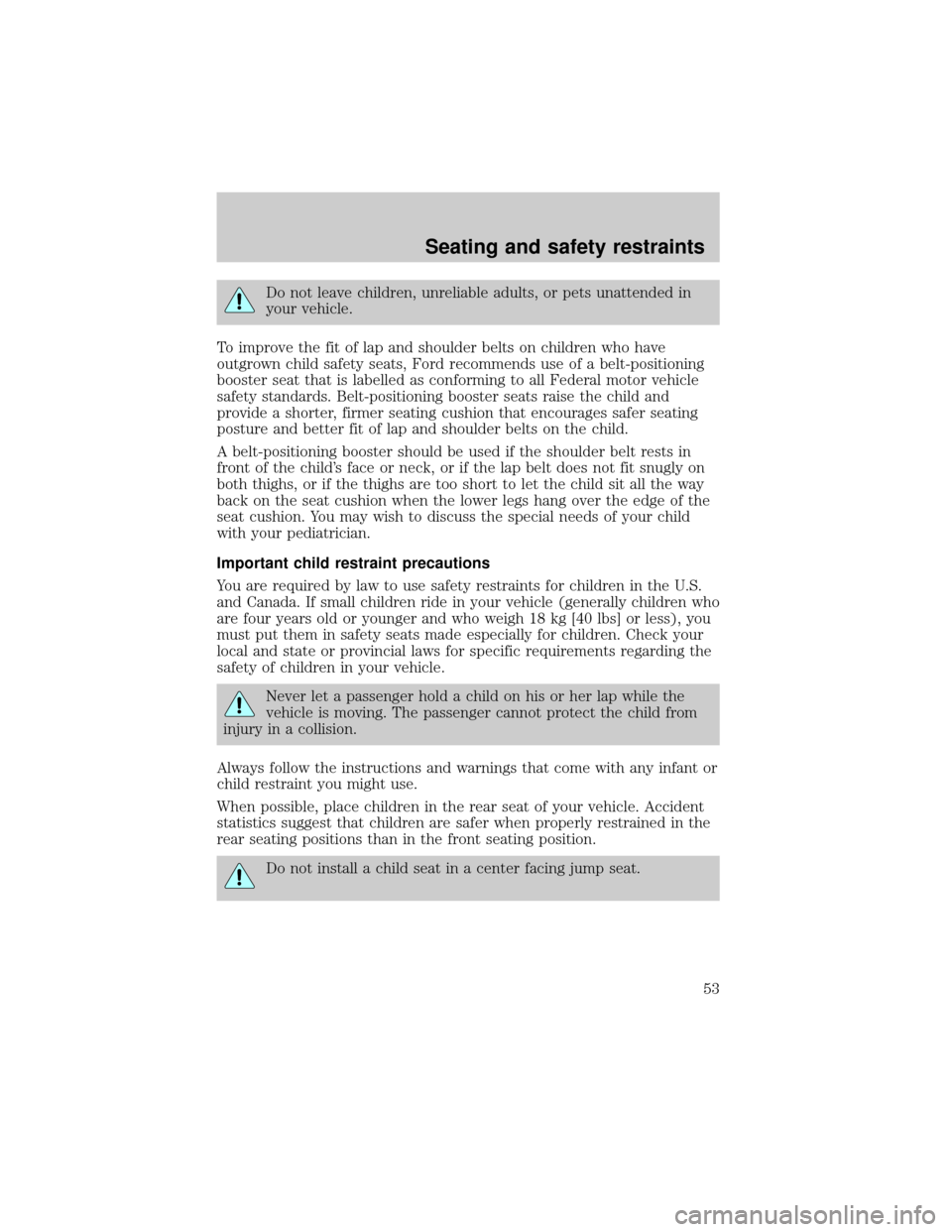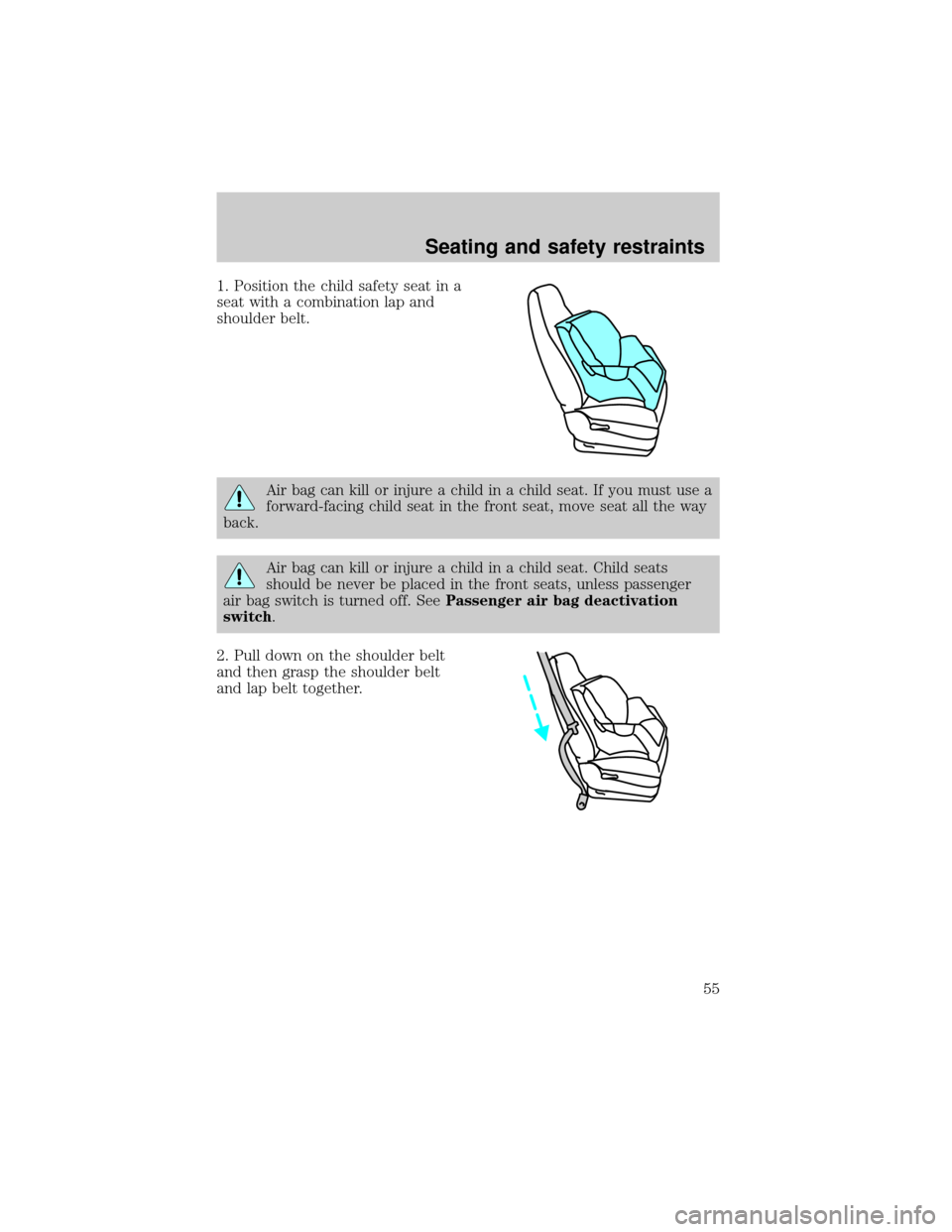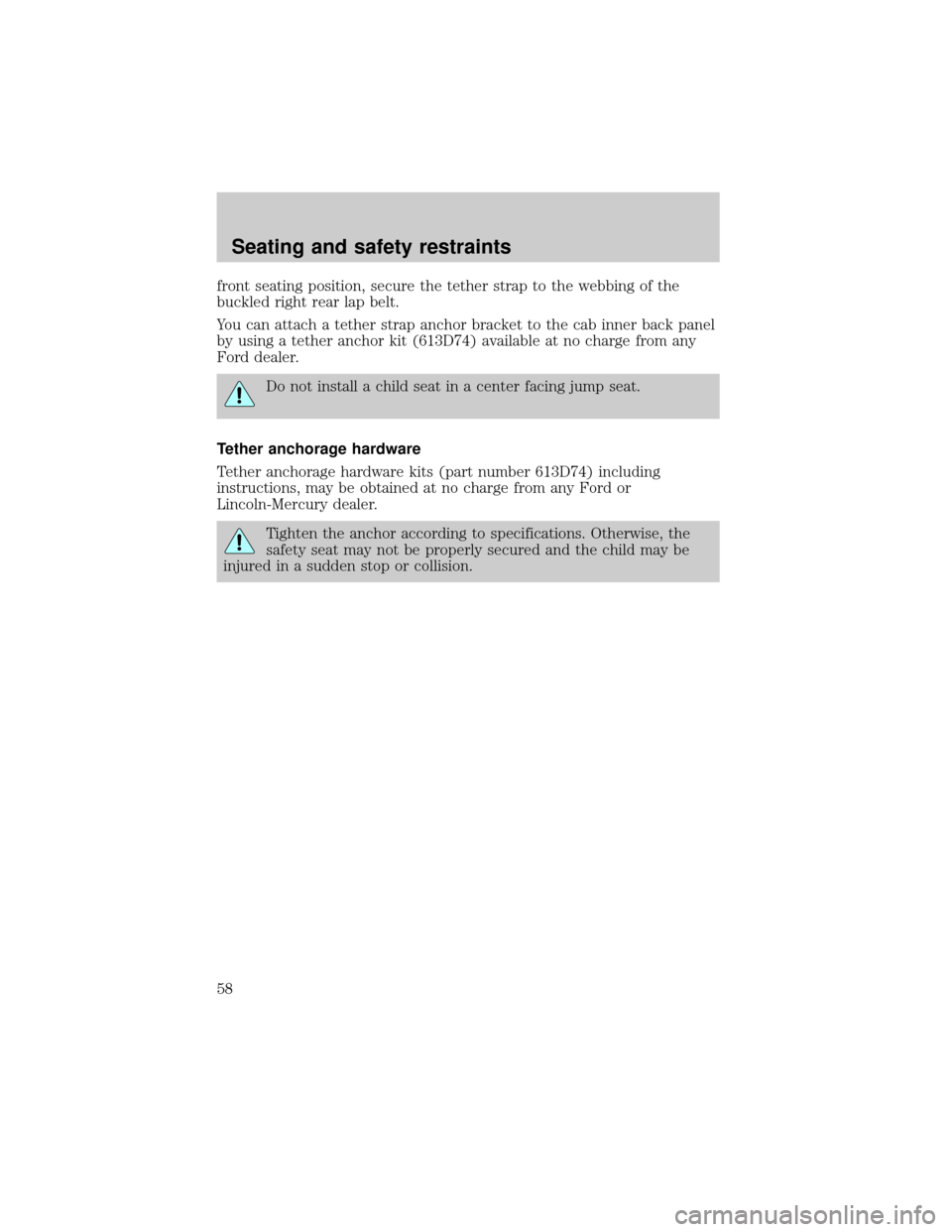1998 FORD RANGER child restraint
[x] Cancel search: child restraintPage 52 of 160

Turning the passenger air bag back on
The passenger air bag remains OFF until you turn it back ON.
1. Insert the ignition key and turn
the switch to ON.
2. The OFF light will briefly
illuminate when the ignition is
turned to On. This indicates that the
passenger air bag is operational.
If the light is illuminated when the passenger air bag switch is in
the ON position and the ignition switch is in ON, have the
passenger air bag switch serviced at your Ford or Lincoln-Mercury
dealer immediately.
Keep the passenger air bag turned on unless there is a child seat
installed in the front seat. When the passenger air bag switch is
turned off, the passenger air bag will not inflate in a collision.
CHILDREN AND SAFETY BELTS
Children who are too large for child safety seats (as specified by your
child safety seat manufacturer) should always wear safety belts.
Follow all the important safety restraint and air bag precautions that
apply to adult passengers in your vehicle.
If the shoulder belt portion of a combination lap and shoulder belt can
be positioned so it does not cross or rest in front of the child's face or
neck, the child should wear the lap and shoulder belt. Moving the child
closer to the center of the vehicle may help provide a good shoulder belt
fit.
If the shoulder belt cannot be properly positioned:
²move the child to one of the seats with a lap belt only (if equipped) or
²if the child is the proper size, restrain the child in a safety seat.
ON
OFF
OFF
PASSENGER AIRBAG
Seating and safety restraints
52
Page 53 of 160

Do not leave children, unreliable adults, or pets unattended in
your vehicle.
To improve the fit of lap and shoulder belts on children who have
outgrown child safety seats, Ford recommends use of a belt-positioning
booster seat that is labelled as conforming to all Federal motor vehicle
safety standards. Belt-positioning booster seats raise the child and
provide a shorter, firmer seating cushion that encourages safer seating
posture and better fit of lap and shoulder belts on the child.
A belt-positioning booster should be used if the shoulder belt rests in
front of the child's face or neck, or if the lap belt does not fit snugly on
both thighs, or if the thighs are too short to let the child sit all the way
back on the seat cushion when the lower legs hang over the edge of the
seat cushion. You may wish to discuss the special needs of your child
with your pediatrician.
Important child restraint precautions
You are required by law to use safety restraints for children in the U.S.
and Canada. If small children ride in your vehicle (generally children who
are four years old or younger and who weigh 18 kg [40 lbs] or less), you
must put them in safety seats made especially for children. Check your
local and state or provincial laws for specific requirements regarding the
safety of children in your vehicle.
Never let a passenger hold a child on his or her lap while the
vehicle is moving. The passenger cannot protect the child from
injury in a collision.
Always follow the instructions and warnings that come with any infant or
child restraint you might use.
When possible, place children in the rear seat of your vehicle. Accident
statistics suggest that children are safer when properly restrained in the
rear seating positions than in the front seating position.
Do not install a child seat in a center facing jump seat.
Seating and safety restraints
53
Page 54 of 160

SAFETY SEATS FOR CHILDREN
Child and infant or child safety seats
Use a safety seat that is recommended for the size and weight of the
child. Carefully follow all of the manufacturer's instructions with the
safety seat you put in your vehicle. If you do not install and use the
safety seat properly, the child may be injured in a sudden stop or
collision.
When installing a child safety seat:
²Use the correct safety belt buckle
for that seating position.
²Make sure the tongue is securely
fastened in the buckle.
²Keep the buckle release button
pointing up and away from the
safety seat, with the tongue
between the child seat and the
release button, to prevent
accidental unbuckling.
²Place seat back in upright position.
²Put the safety belt in the automatic locking mode. Refer toAutomatic
locking mode.
Ford recommends the use of a child safety seat having a top tether
strap. Install the child safety seat in a seating position which is capable
of providing a tether anchorage. For more information on top tether
straps, refer toAttaching safety seats with tether straps.
Carefully follow all of the manufacturer's instructions included
with the safety seat you put in your vehicle. If you do not install
and use the safety seat properly, the child may be injured in a sudden
stop or collision.
Seating and safety restraints
54
Page 55 of 160

1. Position the child safety seat in a
seat with a combination lap and
shoulder belt.
Air bag can kill or injure a child in a child seat. If you must use a
forward-facing child seat in the front seat, move seat all the way
back.
Air bag can kill or injure a child in a child seat. Child seats
should be never be placed in the front seats, unless passenger
air bag switch is turned off. SeePassenger air bag deactivation
switch.
2. Pull down on the shoulder belt
and then grasp the shoulder belt
and lap belt together.
Seating and safety restraints
55
Page 56 of 160

3. While holding the shoulder and
lap belt portions together, route the
tongue through the child seat
according to the child seat
manufacturer's instructions. Be sure
the belt webbing is not twisted.
4. Insert the belt tongue into the
proper buckle for that seating
position until you hear and feel the
latch engage. Make sure the tongue
is latched securely by pulling on it.
5. To put the retractor in the
automatic locking mode, grasp the
shoulder portion of the belt and pull
downward until all of the belt is
extracted and a click is heard.
6. Allow the belt to retract. The belt will click as it retracts to indicate it
is in the automatic locking mode.
Seating and safety restraints
56
Page 57 of 160

7. Pull the lap belt portion across
the child seat toward the buckle and
pull up on the shoulder belt while
pushing down with knee on the
child seat.
8. Allow the safety belt to retract to
remove any slack in the belt.
9. Before placing the child in the
seat, forcibly tilt the seat forward
and back to make sure the seat is
securely held in place.
10. Try to pull the belt out of the retractor to make sure the retractor is
in the automatic locking mode (you should not be able to pull more belt
out). If the retractor is not locked, unbuckle the belt and repeat steps
two through nine.
Check to make sure the child seat is properly secured before each use.
Attaching safety seats with tether straps
Some manufacturers make safety seats that include a tether strap that
goes over the back of the vehicle seat and attaches to an anchoring
point. Other manufacturers offer the tether strap as an accessory.
Contact the manufacturer of your child safety seat for information about
ordering a tether strap.
In SuperCabs equipped with Center Facing Jump Seats, the tether strap
anchor bracket should be installed only at the center of the cab's back
panel with the child seat in the front center seating position. Installing
an anchor bracket at the right rear of the cab may increase risk of injury
to an occupant of the right rear center facing jump seat in the event of a
collision or a sudden stop. If a tether child seat is installed in the right
Seating and safety restraints
57
Page 58 of 160

front seating position, secure the tether strap to the webbing of the
buckled right rear lap belt.
You can attach a tether strap anchor bracket to the cab inner back panel
by using a tether anchor kit (613D74) available at no charge from any
Ford dealer.
Do not install a child seat in a center facing jump seat.
Tether anchorage hardware
Tether anchorage hardware kits (part number 613D74) including
instructions, may be obtained at no charge from any Ford or
Lincoln-Mercury dealer.
Tighten the anchor according to specifications. Otherwise, the
safety seat may not be properly secured and the child may be
injured in a sudden stop or collision.
Seating and safety restraints
58
Page 156 of 160

Aiming headlamps ....................142
Air bag supplemental restraint
system ..........................................47
and child safety seats ..............48
description ................................47
disposal ......................................50
indicator light ...........................50
passenger air bag ...........48,51,52
Air conditioning
manual heating and air
conditioning system .......19,20,21
Ambulance packages ....................3
Anti-lock brake system (ABS)
description ................................66
Anti-theft system ........................35
Battery .......................................128
voltage gauge ............................15
Brake fluid
checking and adding ..............118
Brakes ..........................................64
anti-lock ................................64,65
anti-lock brake system (ABS)
warning light .............................66
fluid, checking and adding ....118
Brake-shift interlock ...................67
Break-in period .............................2
Bulbs, replacing ........................139
headlamps ...............................140
specifications ..........................141
Changing a tire .........................101
Child safety seats ........................54
Chime
headlamps on ............................11
Cleaning your vehicle ...............142
engine compartment ..............143
fabric ........................................146
instrument panel ....................146
plastic parts ............................145
safety belts ..............................146
tail lamps .................................145
washing ....................................142
waxing .....................................143wheels ......................................143
windows ..................................146
Clutch
fluid ..........................................119
Controls ..................................23,31
Driving under special
conditions ....................................77
high water .................................78
slippery roads ......................78,79
Emission control system ..........138
Engine ........................................151
service points ............112,113,114
Engine block heater ...................62
Engine coolant
checking and adding ..............121
disposal ....................................122
refill capacities ........................123
Engine oil ...........................115,117
changing oil and oil filter .......118
checking and adding .......115,117
Exhaust fumes ............................63
Foglamps .....................................16
Four-Wheel Drive vehicles .........74
control trac ..........................22,75
indicator light ...........................75
Fuel
calculating fuel economy .......137
improving fuel economy ..........92
octane rating ...........................136
quality ......................................136
running out of fuel .................137
safety information relating
to automotive fuels ................135
Fuel gauge ...................................12
Fuel pump shut-off switch .........93
Fuse panels
instrument panel ......................95
power distribution box .............98
Fuses .......................................94,95
Gauges, Mechanical
engine coolant temperature
gauge .........................................13
Index
156